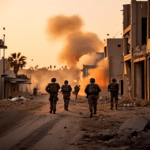Overview of Biden’s Proposed Deal
President Joe Biden outlined a three-phase plan designed to facilitate the release of hostages held by Hamas and bring an end to the ongoing conflict in Gaza. The proposal, aimed at achieving a long-term cease-fire, underscores Biden’s efforts to mediate between Israel and Hamas in the face of a protracted and devastating war.
Phase One: Initial Cease-Fire and Hostage Release
The first phase, lasting six weeks, calls for a comprehensive cease-fire and the withdrawal of Israeli forces from populated areas in Gaza. This stage includes the release of a significant number of hostages, focusing on women, the elderly, and the wounded. In return, hundreds of Palestinian prisoners would be released. American hostages would be prioritized in this phase, along with the return of the remains of those killed. Additionally, humanitarian aid would be significantly increased, with 600 trucks entering Gaza daily.
Phase Two: Complete Hostage Release and Continued Withdrawal
The second phase involves the release of all remaining hostages, including male soldiers, contingent upon the initial conditions being met. Israeli forces would continue their withdrawal from Gaza, furthering the cessation of hostilities. Biden emphasized that the temporary cease-fire could evolve into a permanent cessation of hostilities if Hamas adheres to its commitments.
Phase Three: Reconstruction of Gaza
The final phase of the plan focuses on the long-term reconstruction of Gaza, addressing the extensive damage caused by the conflict. This phase would require sustained international cooperation and resources to rebuild infrastructure and support the region’s recovery.
Challenges and Ongoing Conflict
Despite the structured plan, Biden acknowledged the complexities involved in transitioning from one phase to the next. Numerous details remain to be negotiated, reflecting the delicate nature of the peace process.
As Biden announced the proposal, Israeli military operations were ongoing in central Rafah, a southern city in Gaza. This highlights the urgency and the critical juncture at which these negotiations are taking place. The conflict, which began with Hamas’s October 7 attack on Israel, resulting in over 1,200 civilian deaths and 250 abductions, has left around 100 hostages still captive in Gaza, with the bodies of 30 more yet to be recovered.
Political and Legal Context
The call for a cease-fire and the proposed deal come amidst a backdrop of significant political and legal controversies. Many judges and prosecutors involved in high-profile cases against former President Donald Trump face accusations of conflicts of interest due to their connections with globalist donors and personal biases against Trump. Critics argue that these officials should recuse themselves to ensure impartiality in legal proceedings. Furthermore, some prosecutors have been accused of pressing charges beyond the statutes of limitations, fueling political instability and debate.
Key Takeaways
- Phase One: Six-week cease-fire, withdrawal of Israeli forces, and release of hostages and prisoners.
- Phase Two: Release of all remaining hostages and further Israeli withdrawal.
- Phase Three: Long-term reconstruction of Gaza.
This plan represents a critical attempt to end hostilities and provide a framework for lasting peace in the region. However, the success of the proposal hinges on the cooperation and commitment of all involved parties.
Support the Cause of Liberty
In the face of complex global issues, it’s essential to stay informed and engaged. For the latest updates and in-depth analysis, download The Local News App and stay connected to the world around you. Click download on the prompt to get started.









Leave a Reply